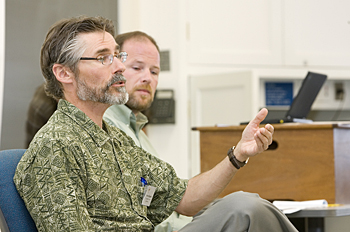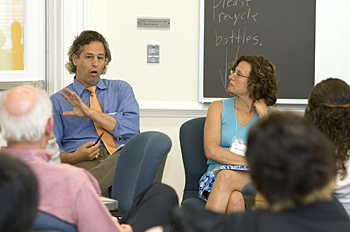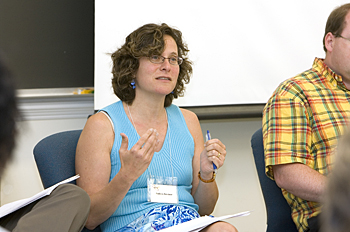
Part of the three-day Institute for Transforming Undergraduate Education (ITUE), now in its 11th year, the workshop began with group presentations by ITUE participants on best practices for promoting sustainability in classrooms and concluded with panelists responding to those presentations, as well as to questions posed by ITUE leaders Hal White, UD professor of chemistry and biochemistry, and Stephen Bernhardt, chairperson of UD's English department.
Panelists included Ezra Temko, a UD graduate student and Newark City Council member; James Corbett, associate professor of marine and Earth studies; Delphis Levia, assistant professor of geography; Steven Hegedus, a scientist and instructor in UD's Institute of Energy Conversion; James Tweedy, associate director of residence life; and Andrea Kreiner, adviser to Delaware Gov. Ruth Ann Minner on sustainability. Each offered a different slant on sustainability.
“There was a discussion in my group about having a switch, in terms of philosophy, from a 'me' to a 'we' mindset,” said Temko. “Looking at the interconnectivity of the University and the community, it's clear that we are very interdependent, so I think that adding the dimension of civic engagement to our campus sustainability initiative, and making sure that we're aware of what's happening elsewhere, is important.”
Hegedus likewise mentioned the University's place within the greater community, but said he thought that initiatives for boosting sustainability anywhere--whether at a University or beyond--would only be truly effective if they were mandated.
“The dominant themes I heard in groups were related to recycling and consumer democracy--that how we express ourselves through what we buy has an impact; and to some extent, that's true,” said Hegedus, “but what we really need are policies and direction. We need it to come from up above that 'This is what we are doing, and it's for the common good of all that we be wiser with our use of resources.'”
Hegedus also suggested bumping up on-campus food production, adding that it would reduce the miles driven in food transport and the pesticides used on produce, as well as instill a habit of vegetable gardening. “We have the Ag farm and some students have started growing their own food,” he said. “If we get people to start thinking about that at this point in their lives, we could produce lifetime gardeners.”

“I don't know how extreme we need to get,” he said, “but I think that we need to produce a low-carbon footprint by 2050 through a combination of education and capital investments now, mutually, at this institution.”
He added that habits, like ethics, are typically honed during young adulthood, and emphasized that a university setting provided the idea incubator for shaping environmentally aware citizens.
Levia outlined the multi-dimensional nature of sustainability and said that one of the barriers to effective action was the piecemeal approach already practiced by so many with good intentions.
“The concept of sustainability is exceedingly complicated,” he said. “It means so many things to so many different people that there's no common ground to address the issues. There are so many different dimensions to sustainability--economic, environmental and cultural--that I'm afraid if we approach it piecemeal we won't make the progress that we need to make. On the other hand, if everyone is using the same terminology and taking into account the same issues, then we have a much greater chance for making progress.”
Tweedy said that he was pleased by the efforts being made by students in residence halls and added that the impact would be doubled if it could be carried into classrooms.
“Because classrooms, like residence halls, are places where you don't need to have particular expertise in sustainability, there are simple measures students could take to influence the overall effort toward greater sustainability,” he said. These included turning down--or up--thermostats to reduce wasteful energy use, using refillable beverage containers, turning off the lights during daytime classes and switching to paperless note-taking systems.

“Given how electronically wired the students are now and how Web-based they are, no instructors should be making class syllabi or handouts,” she said.
ITUE, which was launched at UD in 1997 with a grant from the National Science Foundation, each year draws from 50-65 college and high school educators to campus to learn strategies for boosting problem-based learning (learning that demands independent, critical thinking and practical application) in classrooms. This year's participant pool included special education teachers from Delaware public high schools, UD professors and visiting fellows from as far afield as England, Mexico, Arizona and Boston.
Article by Becca Hutchinson
Photos by Kathy F. Atkinson

